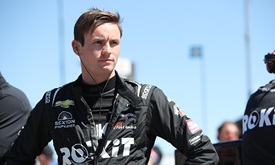INDYCAR Flagger Racing To Increase Autism Awareness
APR 01, 2022
Note: April is National Autism Awareness Month, and April 2 is World Autism Awareness Day 2022.
When Aaron Likens was 20 years old, he assumed he would never have a job, never have friends and never be happy.
That’s what an internet search told him one night in 2003 when he was diagnosed with Asperger’s syndrome, a neurodevelopmental disorder characterized by significant difficulties in social interaction and non-verbal communication, along with restricted and repetitive patterns of behavior and interests. In 2013, it officially became part of one umbrella of diagnosis of autism spectrum disorder.
Up until this point in his life, Likens knew he had passionate, repetitive interests in weather and auto racing. But he didn’t understand why people didn’t have the same knowledge or interest in these topics that he did. He thought everyone else were the “weird ones,” he said.
After his diagnosis, he fell into a deep state of depression. He couldn’t find logic in the turn his life had taken. In his mind, failure was a guarantee, so why try? This went on for 14 months.
“I thought this was a death sentence, and I'm never going to be able to do anything,” he said. “When I read that, I unfortunately allowed that diagnosis to define me. I say that I was five stages beyond depression.”
For over a year, Likens let this website dictate who he was and how he was going to live his life. As his state of depression continued, Likens struggled to explain what he was going through. He was never good explaining his feelings or emotions.
But he needed out. So, he started writing in a journal. He never enjoyed writing growing up, but this was his last resort. He couldn’t speak his emotions, so how about writing them? This let his brain access thoughts he never had before. It was a new outlet for him, and it allowed him to explain to his parents who he was and why.
Likens kept writing to the point where he had had a full book’s worth of thoughts, stories and explanations for people on the autism spectrum. In 2012, he self-published his book, and a division of Penguin picked up the story. “Finding Kansas” has sold nearly 15,000 copies to date.
Now having given 1,100 presentations to about 95,000 people at schools, FBI offices, police headquarters and more, this is Likens’ life.
“I wish I could go back to who I was in 2005 when I first started to write and say, ‘Aaron, you have no idea what’s going to happen,’” he said. “’You have no idea. Stay with it.’
“I wouldn’t trade anything in the process to getting here.”
This isn’t what Likens had planned for his career. He stumbled into a career as an author and an advocate for autism awareness while on his journey to become a flagger in auto racing.
Likens is from Indianapolis but moved to St. Louis when he was a kid. His first trip to the Indianapolis Motor Speedway was for an Indy 500 practice day in 1987, and his first Indianapolis 500 was in 1989. He was enamored with the speed, color and competition of the race cars.
But more than that, he was fascinated by the man in the flag stand waving the green flag to start the race and checkered flag to end it. Likens didn’t see Unser, Andretti or Rahal as his hero. Instead, his hero was Duane Sweeney – chief starter of the Indianapolis 500 for decades.
In 1990, he asked Sweeney for an autograph. Sweeney had his wife, who handmade two checkered flags for the Indy 500 each year, make a third flag for Likens, which he signed. That flag, which Likens would sometimes wave at passing cars in his neighborhood while standing on a rock next to the street, is safely tucked away in his basement.
That set Likens on a path to wanting to be a flagger for his career. His first opportunity came at age 13 at his local go-kart track in St. Louis when he wasn’t competing in go-kart races himself.
Then, he started flagging for the St. Louis Karting Association from 1996-2005 before moving to USAC at the urging of former IMS Historian Donald Davidson, who said most flaggers got to the INDYCAR SERIES through USAC.
Then he received an opportunity to join the NTT INDYCAR SERIES in 2020 as a flagger. His first time officially flagging an NTT INDYCAR SERIES event came during the GMR Grand Prix that July on the IMS road course, when he was in the stand for qualifying.
Likens became one of two flaggers for the NTT INDYCAR SERIES, traveling the country and helping to officiate North America’s premier open-wheel series. Then, in 2021, the opportunity of a lifetime fell into his lap.
Likens’ co-worker in the flag stand with whom he rotates main flagging duties offered him the Indianapolis 500 presented by Gainbridge job from start to finish, in which he waved the dual checkered flags for Helio Castroneves in one of the most historic finishes in “500” history.
Twenty-two years after that young kid was enamored with the man waving the flag at the Racing Capital of the World, Likens suddenly was that man.
“I'm a writer, so I should have the words for it, right? It's impossible,” he said. “I've watched snippets of the race, and it doesn't seem real. I can relate with every sports movie now in the final scene when whatever goal was achieved. And as an audience, you're sitting back and all that must be so amazing.
“When you're in it. You're just in a blur or you're in a fog. This it's a once-in-a-lifetime moment you wait for forever, and when you get there it's so overwhelming that there's a beautiful numbness to it.”
While Likens’ eyes are always on the Month of May and ready to help flag “The Greatest Spectacle in Racing,” again, he has a special appreciation for World Autism Awareness Day on April 2.
When he was diagnosed with Asperger’s syndrome, awareness for the disorder was extremely low. Even Likens’ doctor who read the assessment didn’t even understand what it meant. So, Likens is on a mission to change that.
He grew up wanting to race and to be involved in racing. Now, he says, he still wants to do that, but in a different context.
“I still want to race. But it’s a new race now,” he said. “The race to spread as much awareness and understanding as possible, because there’s so much hope out there for all people on the autism spectrum.”
When Likens was born, the rate of autism was 1-in-1,500. Today, according to the CDC, the rate is 1-in-44. With more people being diagnosed with autism, Likens believes its vital to continue to raise awareness and help the world understand people with this disorder.
He also wants everyone to understand that not all cases of autism are the same, and it takes time to understand how to help each individual person. He insists that he would not have overcome so many of his own obstacles had he not had people take time to understand who he was and what he needed to succeed.
“Each person’s growth is limitless with more awareness around them and more understanding,” he said. “I think we’re at a point now where people are aware of autism. When I was first diagnosed and I told people I had Asperger’s, people hadn’t heard of it. It’s World Autism Awareness Day, but we’re transitioning to World Autism Understanding Day.
“The journey for me to get here, I wish I could stand up on a pedestal and say, ‘Look at what I did,’ but it wasn’t me. It was teachers, my parents and so many other people who planted the seeds. Part of the story of Autism Awareness Day is that behind so many of us that have made it, and made it is a subjective term, it was because of the awareness and understanding of those around us.”
Now, Likens is ready for the next NTT INDYCAR SERIES race, the Acura Grand Prix of Long Beach on Sunday, April 10 (3 p.m. ET, live on NBC and INDYCAR Radio Network), where he will be the leading flagger in the stand.
More importantly, Likens has a job, friends and is extremely happy.



















